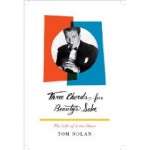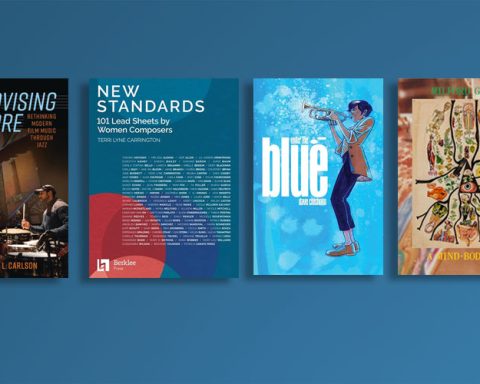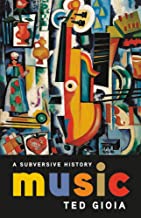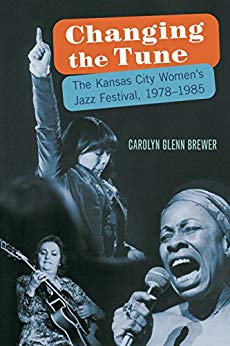 Three Chords for Beauty’s Sake: The Life of Artie Shaw
Three Chords for Beauty’s Sake: The Life of Artie Shaw
By Tom Nolan
W. W. Norton, New York, 2010; 430 pp.; $29.95 hardcover
I was wrong about Artie Shaw. I thought, since I heard that he stormed off the stage at the peak of his career over a fan’s umpteenth request for (fill in the blank) “Begin the Beguine,” “Star Dust” or “Frenesi,” that the music business had made Shaw curmudgeonly. After reading Tom Nolan’s eminently readable bio, I now understand that Shaw was born a curmudgeon, both on and off the bandstand, with his wives and fans.
Three Chords For Beauty’s Sake flows through Shaw’s lives — musical and personal — and his women, legendary and otherwise. Shaw was married eight times; Dick Johnson, a former sideman turned leader, once told me that Shaw might have neglected to divorce one wife to marry the next one. “Luckily, she died,” he quipped. (No names, please).
Nolan dwells at length on the dueling relationship between Shaw and Benny Goodman. Shaw and Goodman’s brother-in-law John Hammond have confirmed a dinner conversation related by Nolan between the two when Goodman argued, “It’s about the clarinet, Artie.” “No, it’s about the music,” Shaw replied. And so it went for decades.
There are other surprises in Three Chords. (The title stems from what bands would present to their audiences: Three of their own, one for the rent, preferably a hit.) Shaw was a pioneer in integrating bands with the likes of Lena Horne, Hot Lips Page and Roy Eldridge. The usual black/white idiocies apply here. When Billie Holiday was in the band, Artie vacillated and in the end caved. Nolan relates how the band once checked into a swanky hotel surrounding Lady. However, when he was told that she had to leave the bandstand after her numbers or forego a lucrative concert, he told her, “It’s not me, but….” Lady split soon thereafter. It was much later that her sides with the band were released. Notable among them was “Any Old Time” which the band re-recorded with Helen Forrest, who all but impersonated Lady’s inflections. Forrest eventually left Shaw for Goodman for less money. Contrarily, on another occasion Shaw had a doorman fired for not allowing Eldridge to enter by the front door.
Nolan’s style is often dramatic. Sportscaster Bill Stern loved to tell a story about some event or other, then conclude: “And that one-legged first baseman was none other than….” Nolan tells of an incident then announces — I paraphrase here — “and that blond airhead was….” The difference is that Stern’s stories were fictitious.
On the subject of honesty: I was once a book finder for DaCapo Press, then a reissue house. I “found” Shaw’s first autobiography, The Trouble With Cinderella. Don’t ask me where I got the chutzpah to call, or even where I got his home number, but call I did. I told him of my plan. His reply: “Why do you want to reissue that novel?” Pregnant pause. Was he telling me Cinderella was fiction? As Nolan points out about Shaw’s ego, it got the better of him and the book was subsequently reissued. That was 30-odd years ago; Shaw and I remained “friendly” — a term Nolan states Shaw loved to abuse — till his death in 2004. (Perhaps Cinderella might have less to do with fairy tale than with a club in Cleveland where Shaw got a big leg up in the early going.)
In 1928 Shaw had met and played with Bix Beiderbecke alums in a band called “Sons of Bix.” The pianist was Hoagy Carmichael and “Star Dust” was in the band’s book. Shaw didn’t pay it much notice until a decade later when he was asked to cover the tune as it was making some noise by other bands. Shaw didn’t want to use a vocalist — Tommy Dorsey recorded it as a vehicle for his “boy singer” Frank Sinatra whom Shaw had spurned — so he had an instrumental arrangement written for his band, which had become an orchestra with the addition of a string section. Among all the thousands of recordings of “Star Dust,” the Shaw version sold millions and remains a swing hallmark. According to Carmichael’s son Bix, Shaw’s was the composer’s favorite. Nolan: “It was a just a well-known song; Artie made it a standard.”
Shaw’s boudoir events became legendary. Between Mickey Rooney, Tommy Manville (a mid-20th century playboy) and Shaw there weren’t many other Hollywood women to go around. This obsession carried over into Shaw’s creativity. He formed a small group named for his telephone exchange in New York, the Gramercy Five. The first hit was a blues named after his new California address, “Summit Ridge Drive.” It featured Italian string manufacturer scion Johnny Guarnieri on harpsichord. (Other G-5 incarnations featured pianist Hank Jones on the more traditional piano bench as well as Dodo Marmarosa and Billy Taylor.)
There is so much more that Nolan tells of Arthur Arshawsky from the Lower East Side: his near-fatal naval career, his chamber and orchestra music, his often abusive treatment of his ever-more glamorous wives and girlfriends (including an infatuated teenage Judy Garland), his foot-in-mouth disease which caused him to lose drummer Buddy Rich to Dorsey, the rock star-like adulation, his estrangement from his son, his hatred of his father and his ambivalence towards his mother.
All of which contributed to the prominent desire to see his style of unrelenting musical brilliance outlive him. In the end he said, “The clarinet saved my life.”






l. While Shaw indeed "integrated bands" with Page and Eldridge, not so with Lena Horne, used on a record date only (an interesting one, with Red Allen, J C Higginbotham, Benny Carter, and all-black rhythm section, and Artie's first arrangements for strings), not in live performance. Of course his last groups were, what with Hank Jones and Tommy Potter.
2. Star Dust was in Shaw's book well before the famous l941 recording; there are two issued air checks from 1938 (with of course a different arrangement), and one of these was even selected by Artie for the "Personal Best" Bluebird CD Aside from having been famously waxed in 1931 by both Bing and Louis, the song was already such a standard in 1936 that Victor uniquely coupled versions by Goodman and Tommy Dorsey on a single. And Jack Jenney's 1939 version (his famous solo was abridged on Artie's recording} was yet another famous earlier instance. The Shaw-Hayton-Butterfield-Jenney-Shaw is a wonderful record, but surely did not put the song on the map, nor am I sure it was a million seller--maybe over the years. As for the "Sons of Bix", I find no mention of this Hoagy-Artie 1920s encounter in any other source consulted.
3. There are no :"sides" by Billie with the Shaw band, only one side, "Any Old Time" (one of Shaw's better songs), and the Helen Forest "cover" was made because Billie was under contract to another label.
4. Nolan is better on the life than on the music.
Grateful as I am for Mr. Smith's enthusiastic review, I must correct the impression he gives (and which
Mr. Morgenstern echoes) that my "Three Chords for Beauty's Sake: The Life of Artie Shaw" (Norton) claims that "In 1928 Shaw had met and played with Bix Beiderbecke alums in a band called 'Sons of Bix.”'"
Here's the totality of what I wrote in describing how Shaw in 1928 went with the Joe Cantor band from Cleveland, Ohio, "to Richmond, Indiana, to make four sides for the Gennett label. Shaw, his first time in a recording studio, paid close attention.
"There the Gennett people played them a record some other kids had made not long before: an instrumental by the group's piano player, Hoagland Carmichael. It was a jazzy line that shifted in and out of the beat; it was obvious 'Hoagy' had written a tune taking off from Bix's style. Carmichael called his number 'Star Dust.' "
Thank you for bringing my book to your readers' attention.
Sincerely,
Tom Nolan
There is definitely some history behind Artie Shaw. Three Chords For Beauty’s Sake is a look into his life and his cruel treatment of others. Should be a very interesting read.